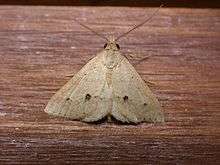Gesonia obeditalis
Gesonia obeditalis is a species of moth of the family Noctuidae first described by Francis Walker in 1859. It is found from eastern Africa, the Seychelles, the Maldives and the Oriental tropics of India, Sri Lanka east to the Philippines, the Sula Islands and Australia.[2][3] The adult moth has brown wings with a scalloped dark brown band near the margin. The hindwings are similar in pattern to the forewings but are a paler shade of brown.[3]
| Gesonia obeditalis | |
|---|---|
 | |
 | |
| Scientific classification | |
| Kingdom: | |
| Phylum: | |
| Class: | |
| Order: | |
| Family: | |
| Genus: | |
| Species: | G. obeditalis |
| Binomial name | |
| Gesonia obeditalis | |
| Synonyms | |
| |
Description
The wingspan is about 22–24 mm (0.87–0.94 in).[3] Antennae of male serrate and fasciculated. Body fuscous or rufous brown. Palpi chocolate at sides. Forewings with traces of antemedial and postmedial waved lines, where postmedial line curved inwards below cell. There are traces of specks in and at end of cell. An obliquely sinuous postmedial pale line found with rufous diffused on its outer edge with a marginal dark specks series. Hindwings with postmedial line developed towards inner margin. A marginal series of dark specks present. Traces of medial and submarginal lines can be seen. Some specimens have a dark spot beyond the postmedial line of forewings at middle, and another above inner margin. Some has ochreous ground color in forewings as far as submarginal line and another has color between antemedial and postmedial line fuscous black.[4]
Life cycle
The larvae feed on Gramineae (grass) species, as well as Stylosanthes species. They live stretched on the stems of their host plant and feed on the flower spikes. Pupation takes place in a white, silken cocoon that incorporates debris. The larvae are light yellow with seven longitudinal brownish-orange bands.[5] Two pairs of prolegs are missing so the caterpillar moves by looping.[3]
References
- "Species Gesonia obeditalis Walker, 1859". Australian Faunal Directory. Retrieved 29 October 2016.
- "Gesonia obeditalis Walker". The Moths of Borneo. Retrieved 15 August 2016.
- Herbison-Evans, Don & Crossley, Stella (19 September 2008). "Gesonia obeditalis Walker, 1859". Australian Caterpillars and their Butterflies and Moths. Retrieved 15 January 2019.
- Hampson, G. F. (1894). The Fauna of British India, Including Ceylon and Burma: Moths Volume II. Taylor and Francis – via Biodiversity Heritage Library.
- "Gesonia obeditalis Walker, 1859". African Moths. Retrieved 15 August 2016.
| Wikispecies has information related to Gesonia obeditalis |
| Wikimedia Commons has media related to Gesonia obeditalis. |